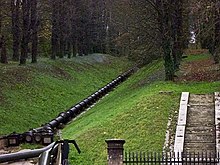Plumbing
The plumbing, plumbing or gasfitería is the activity related to the installation and maintenance of pipe networks for the supply of drinking water and sewage disposal, as well as heating installations in buildings and other constructions.
Etymology
The name "plumbing" derives from "plumber", which comes from "fontana", which is synonymous with "source" and in turn comes from the Latin fontāna.
The name "plumbing", used in some Latin American countries, comes from the traditional use of lead in pipes. Glass and window repair
The term "gasfitería" derives from "gasfiter" or "gasfitero", an anglicism used in Peru and Chile that comes from the English gasfitter.
History
The history of plumbing goes back to the times of Ancient Rome, who already built stone aqueducts to conduct water to the facilities of the palaces of their emperors and their famous baths, as well as sewers to evacuate it once used. Modern plumbing has its beginnings at the end of the XIX century with the use of cast iron pipes to conduct water, which were soldered with lead, which was melted by a burner and then poured into the joints. This system was used until the end of the 1970s, although it is still used for other types of facilities not related to human consumption. Currently, in most Western countries the use of the cast iron-lead system is prohibited, both for the conduction of drinking water and for the evacuation of wastewater. The reasons are that with the internal wear of the pipes due to friction, small lead particles mix with the water, causing plumbosis in consumers; on the other hand, its work is slow, complex and very expensive compared to other more modern materials such as copper, PVC, high-density polyethylene (HDPE) and many others.
Today, lead solder has been replaced by several systems, depending on the material of the pipe: steel solder, for steel tubes; gas welded tin, for copper tubes; solvent adhesive, for PVC pipes; thermofusion for polypropylene and/or polybutene tubes; cement mortar for concrete pipes and special pastes for asbestos-cement pipes. There are also mechanical unions, which can be compression or flanged or threaded.
Water pipes
A water main is a water conveyance network made up of pipes, often made of plastic or metal, that carries pressurized and treated fresh water to a building (as part of a municipal water system). water), as well as inside the building.
Evolution
Lead was the preferred material for water pipes for many centuries, as its malleability made it practical to shape into any desired shape. Its use was so common that the word "plumbing" It derives from plumbum, the Latin word for lead. In the years before the health risks of ingesting lead were fully understood, lead was a source of lead-related health problems, including stillbirths and high infant mortality rates. Lead water pipes were still in wide use in the early 20th century century and remain in many homes. Lead-tin alloy solder was commonly used to join copper pipe, but modern practice uses tin-antimony alloy solder instead to eliminate lead hazards.
Despite the common use of lead pipes by the Romans, their aqueducts rarely poisoned people. Unlike other parts of the world where lead pipes cause poisoning, Roman water had so much calcium that a layer of plaque prevented the water from coming into contact with the lead itself. What often causes confusion is the large number of cases of widespread lead poisoning, especially among those who would have had easy access to running water, an unfortunate result of lead's use in cookware and as an additive in processed foods and beverages. (for example as a preservative in wine). Inscriptions on Roman lead pipes provided information about the owner to prevent water theft.
Wooden pipes were used in London and elsewhere during the 16th and 17th centuries. The pipes were hollowed-out logs that tapered at the end with a small hole through which the water passed. The multiple pipes were sealed together with hot animal fat. Wooden pipes were used in Philadelphia, Boston, and Montreal in the 1800s. Recessed wooden pipes were widely used in the United States during the 19th century XX. These pipes (used in place of corrugated iron or reinforced concrete pipes) were made from sections cut from short lengths of wood. Locking adjacent rings with hardwood dowels produced a flexible structure. During World War II some 30,000 meters of these wooden pipes were installed in drainage culverts, storm drains and conduits, under highways and in army camps, naval stations, airfields and artillery plants.
Cast iron and ductile iron pipe were long an inexpensive alternative to copper before the advent of durable plastic materials, but special non-conductive fittings must be used at transitions to other metal pipe (except end fittings) to avoid corrosion due to electrochemical reactions between dissimilar metals (see galvanic cell).
Bronze fittings and short pipe segments are commonly used in combination with various materials.
Tools
These are the main tools needed to carry out a plumbing work.
- Soplete
- Pressure clamps
- Extendable food
- English Key
- Desatascador or chupona
- Metric tape
- Key griff
- Aluminum stumble
- Copper shorts
- Copper Curve manual
- Electric Copper Curve for Large Diameters
- Dream for the joints
- Chain Key
- Shorts for pvc of various measures
- Machine drilling
- Crown for drainage
- Multi-type screwdrivers
- Copper Scanner
Tools for lead repairs
Lead installations still exist, for their repair the following tools are used:
- Lead abocarder
- Lead scissors
- Welding preparation tuning
- Fundidor
- Special thread for welding
- Spelma and tin of 33% for welding
- Barrena
- River sand to curve lead
- Welding lab
- Sterling
Products
- Hooker for pipe
- Caper
- PVC, copper and lead pipe (unused).
- Corrugated plumbing tube (propylene).
- Balloon valve
Contenido relacionado
Autonomous University of Baja California
Mars Gravity Biosatellite
Universal design




